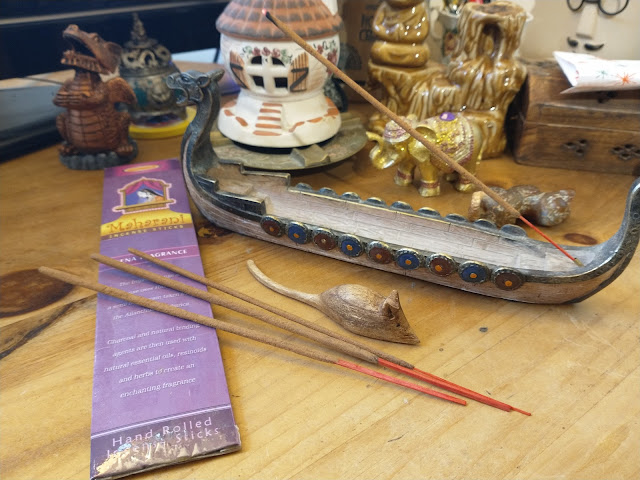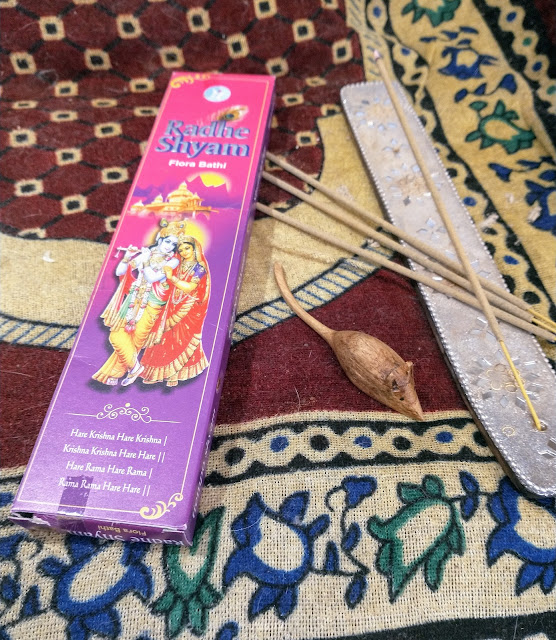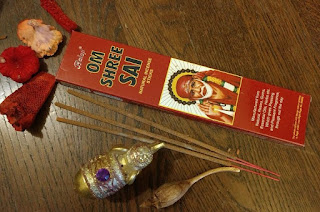Flora and Fluxo are terms used in Indian incense, generally for masala incense. The oldest use of these terms I am currently aware of is in the successful and popular (mostly in India)
Sri Sai Flora Fluxo Incense, which is quite oily, thick, and intense.
I'm currently looking into Flora and Fluxo incense to understand these terms, and to see if there is any difference between when these terms are used, and if so what that difference is. As reported in my review of the Hari Om Fluxo, some Indian agabathi makers seem to regard Fluxo as another term for masala incense, though perhaps fatter and richer? Flora named incenses are normally also masala, though I've had some which were perfume-dipped, such as Moksh Swarna Sai Flora Batti. Most Flora is fat and rich, such as Balaji Red Premium Flora Sticks, though some, such as Sagon Sainath Flora Bathi, can be fairly dry and more like a standard masala. When looking back at my reviews of Flora and Fluxo incense I noticed that Supreme was also a term used for fatter and richer masala incense, such as Gokula Vrindavan Supreme, Happy Hari Meena Supreme, and Satya Supreme. On the whole I am tending to the thought that Flora, Fluxo and Supreme are terms generally used for fatter, richer masala incense, though - as is the way with a number of Indian agabathi makers, the terms are sometimes used just for marketing, as with the Moksh, so could be seen as having no more significance than the word "premium".
Some suggestions given to me by various Indian incense makers are that, while there is no defined definition or classification of "flora" and "fluxo" (and other terms such as "durbar", "supreme", "absolute", etc), and that each maker will use the terms as they see fit, a "flora" will tend to be a higher quality masala, or will contain more oils, or will be softer and more refined. Nobody has suggested that the term refers to floral, though I suspect that it links in with a common term in India for masala incense, and that is the term "natural" - as "flora" means plants, which is what a masala or natural incense is mostly made from, as opposed to a lab made scent. The terms "natural" or "herbal" seem to me, based partly on anecdotal evidence of the incenses I have burned, partly on trawling through Indian incense company brochures and websites, and partly on the research I have done, to be much more frequently used in India than "masala", which is more common in the West. My observations are (with rare exceptions such as that of the revived Bangalore incense company ELIF who feel that many incense companies do not make proper "flora" incense these days, and who are attempting to recreate the sorts of quality "flora" incense that the founder of ILIF, their father who died recently, used to make) that "flora" has no more significance than "natural", and is just another description for masala incense, and is used to differentiate incense made using plant based fragrance, from incense made using lab produced fragrances.
"Fluxo" means flow, and one incense maker has suggested that "fluxo" incense is more flexible, while a couple of others have connected it to Earth's energy, derived from plant life. "Fluxo" is not used as much as "flora", and when it is, it is mostly used in incense which is quite obviously copying
Sri Sai Flora Fluxo - the original "fluxo" and the original "flora" (as far as I've been able to discover - if there are earlier examples, please let me know!).
I will add to this as I go along....
I've still not quite pinned down exactly what is meant when Indian incense companies describe their sticks as Flora. There appears to be a sense that it means "premium", and that it is highly likely to be a
masala style incense, another term with flexible and variable meaning. The main original sense of a masala is that it uses ground natural ingredients - flowers, plants, herbs, woods, resins, spices - for the fragrant ingredients, and these would be folded into the paste rather than added externally. Over time essential oils have largely replaced or supplemented the dried ingredients, and
fragrance oils including synthetic oils are used alongside or instead of essential oils, and these may be diluted with a carrier oil or a solvent such as DEP. The fragrance in some masala style incense may be mostly or even entirely based on fragrance oils, with the stick given a dusting of wood powder (melnoorva or masala powder) to give the appearance of being a traditional masala stick. The wood powder may itself be fragrant, or an oil may be added to the finished stick. Adding the powder and external scent is an extra process which adds to the cost, but does give a good appearance, and gives a welcoming scent on the stick and when opening the packet. Perfumed incense has that scent because the fragrance has been added externally. As a masala traditionally has the fragrance locked inside the paste, it doesn't have much of a scent on the stick. Adding an external scent gives the customer some reassurance of a quality product.
I say this without pointing any fingers, and without hard evidence - this is just my speculation based on discussions with Indian incense houses, and my experience with a variety of masala style sticks. Anyway - a Flora stick, from my experience, appears to be a stick that is influenced by
Sri Sai Flora Fluxo, and will tend to be weighty and rich with oils. However, I have encountered a number of sticks which are termed Flora, which are not weighty, and which may be quite dry. Discussions with Indian incense houses tends to give me the impression that a Flora is regarded as a traditional incense of some quality, though the specifics beyond that vary, so the main sense appears to be "a premium or quality masala style stick". There are no actual scents or ingredients or production methods which appear to define Flora - it appears to be mainly a designation of quality. The preference would be that it is a hand made masala style stick rich and weighty with fragrant oil, but it is up to each incense house to decide themselves what they term a Flora, and how they make it.
I'm becoming aware that most
luxury boxes contain "Flora" style incense, and that most "Flora" style incense is sold in luxury style boxes. There is a relationship. At least in India - when Flora style incense is packaged for a Western reseller such as Happy Hari, TOI, or Bhagwan, they use the same packaging as for the rest of their output.
When reviewing
Ramakrishna's Natural Handmade Incense Sticks Sunset I noted that the sticks were rough looking and tended to go out. Flora/fluxo/supreme styles can be like that. The flora
masala paste seems to be difficult to roll and dry in a tidy fashion. Some people have said that halmaddi is a substance that attracts moisture, and so a flora stick is wet because of the halmaddi.
Halmaddi, like all tree resins, such as frankincense and gum Arabic, are
hygroscopic. So is any natural material, such as plants, leaves, flowers, and especially sawdust and charcoal, which are very absorbent, and make up the majority of any incense. That's why it is important to store incense in a dry place. Halmaddi, as with other tree resins, hardens with exposure to the air. That is the purpose of the resin.
It is there to protect the tree from losing moisture when it has been cut. Now, we all know that tree resins get hard and brittle -
we know about amber, for example; and those of us who have bought halmaddi know that it behaves the same as other tree resins and goes hard. So shut the fuck up already about halmaddi being the thing that is responsible for incense paste being soft or damp. It's not. It's more likely to be the liquid scents, the oils and perfumes and whatever else liquid, that is added to the paste that must make it wet and soft and heavy. I really don't know what liquids are added, but my assumption, given that floras are not proportionally more expensive than non-flora masalas, is that they are not pure essential oils. I'm not saying that they don't contain essential oils, but if all that fat dampness is the result of pure essential oils then floras would be massively expensive, and they are not, so the liquid content must come from some other less expensive source, which I suspect is mostly
agarbatti oil / DEP. DEP is a plasticiser, like halmaddi and like vanilla crystals (
which are always going to be synthetic), it is used to heighten and prolong the fragrance of the incense. Vanilla scent, for example,
has a half-life of 14 hours. Because of its intrusive nature, not many incense houses use vanilla, though, famously,
HMS do. Anyway, with a dump load of agarbatti oil in with the essential oil(s), a flora style incense is going to make a bigger impact than a non-flora masala. And we all know that floras are about the impact! Big and heady and sometimes overwhelming. Not subtle. Not delicate. Big juggernauts of Indian incense.
Reviews
 |
Jan 2022 - Score: 42↓ |
 |
Feb 2024 - Score: 31 |
***

















































